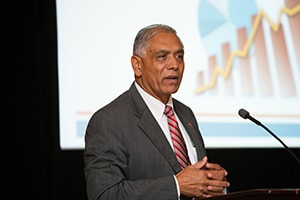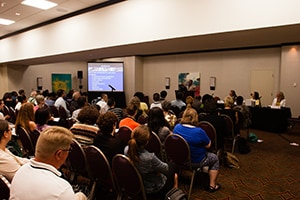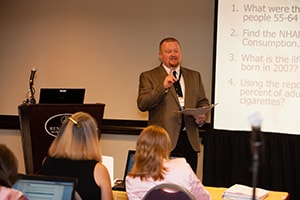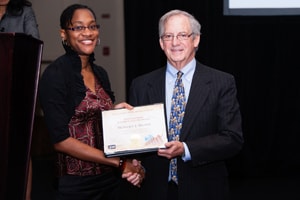2012 National Conference on Health Statistics
More than 1,000 attendees from federal and regional governments, academia, nongovernmental organizations, and the private sector converged on the Renaissance Washington DC Downtown Hotel August 6–8 for the 2012 National Conference on Health Statistics.
Plenary Session Speakers Address Health, Statistical Challenges
National leaders in statistics, health research, and health policy shared the stage at the Tuesday and Wednesday morning plenary sessions. On Tuesday, Ed Sondik gave an overview of NCHS and the current state of health care statistics. Katherine K. Wallman, Chief Statistician of the U.S. Office of Management and Budget, told the assembly that, “We are challenged to change” in the face of a “perfect storm” of budget constraints, dwindling human capital, confidentiality concerns, uncertain respondent cooperation, and “casual” statistics offered by third-party entrepreneurs. Dr. Harold Luft, Director and Senior Investigator, Department of Health Policy Research, Palo Alto Medical Foundation Research Institute, walked attendees through various scenarios highlighting the value of data.
Pamela Hyde, Administrator of the Substance Abuse and Mental Health Services Administration (SAMHSA), kicked off Wednesday’s plenary session by stressing the importance of quality data in developing prevention, treatment, and recovery programs for national behavioral health issues. Dr. Mohammed Akhter, Director of the District of Columbia Department of Health, urged the assembly to take the “people’s point of view–what do they expect, and what do we deliver?” Adequate data, he said, are critical to serious long-term planning for the public’s health. The morning’s final speaker, Dr. Lisa A. Simpson, President and CEO of AcademyHealth, reinforced the human side of health care research and asked her listeners to pay attention to the people behind the numbers: “Your data make you credible. Your stories make you memorable.”
Although each speaker’s presentation reflected their different backgrounds and skills, nearly all raised the issue of increasing demand for data on the subfederal level. “How do we take data collected at the federal level and make it meaningful on the community level as a resource for personal decision making?” asked Dr. Sondik in his introductory remarks. His concern was echoed by Dr. Luft, who noted “state-level data are critical”; Dr. Simpson, who emphasized that “state and local public health officials need data”; and Dr. Akhter, who stressed the need for data collection on a regional basis that crosses jurisdictional boundaries, for effective regional public health planning.
Scientific Sessions Explore Today’s Health Care Issues
The Conference featured 28 scientific sessions held over the two days of the main Conference. Topics touched on nearly every aspect of public health and health statistics, including electronic health records; using local data to improve local health; autism spectrum disorder; the Drug Abuse Warning Network; mortality surveillance; national data and Asian American population health; the new National Survey of Residential Care Facilities; suicide in America; and understanding lesbian, gay, bisexual, and transgender health.
“Does Social Media Have a Role in Federal Statistics?” stood out among the many well-attended sessions. A panel of top communicators representing federal statistical agencies discussed the pros and cons of social media campaigns to increase participation, facilitate dissemination, and connect with a wider general audience. (Conference attendees had an opportunity to participate in social media with NCHS through the Events section of the NCHS Facebook pageExternal
Learning Institute Sessions Give Data Users First-Hand Experience
This year’s Learning Institute featured 16 hands-on session, and 5 lecture sessions on NCHS surveys and resources. Both beginner and advanced sessions were available for the National Ambulatory Medical Care Survey (NAMCS), the National Hospital Ambulatory Medical Care Survey (NHAMCS), and the National Health Interview Survey (NHIS).
The hands-on session demonstrated how to use the Web tutorial for the National Health and Nutrition Examination Survey (NHANES) and the NCHS-CMS (Centers for Medicare & Medicaid Services) linked records. The session was presented by Cordell Golden, Lisa Mirel, and Eric Miller, and filled the Grand Ballroom South to overflowing. Another popular Web tutorial was “Finding Key Resources From NCHS.” The session gave attendees the opportunity to explore the redesigned NCHS website, developed to provide improved navigation and access to NCHS’s extensive resources.
Other sessions delved more deeply into the interactive world of NCHS statistics. The Division of Vital Statistics (DVS) sponsored “VitalStats—Accessing Natality Data Online,” which trained participants in everything from retrieving prebuilt tables to choosing variables to create custom tables. The Office of Analysis and Epidemiology (OAE) presented “Health Data Interactive,” which introduced participants to NCHS’s state-of-the-art data tool. All in all, Learning Institute attendees were pleased with the high quality of the sessions and the opportunity to earn continuing education credits.
Students Shine in Poster Sessions
For 2012, NCHS took student participation to a new level, and students rose to the occasion. The Poster Session this year focused on student research. Nearly half of all abstracts received were from students. Of those, 89 were chosen to display their posters for judging. Three winners—chosen based on best abstract and best poster presentation—were recognized at the Wednesday morning plenary session and were presented with awards. They were Monique Brown of Virginia Commonwealth University, “Beyond Battering: Association Between Intimate Partner Violence and Preventive Screening Behaviors Among Women”; Alena Maze of NCHS, “Identifying Factors Related to the Implausible Gestational Ages Using Mixture Models”; and Tapan Mehta of the University of Alabama at Birmingham, “Obesity and Mortality: Are the Risks Declining? Evidence from a Meta-analysis of Eighteen Prospective Studies in U.S.”
Although students had participated in past Conferences, this marked the first year they participated in such numbers. The program received an overwhelmingly positive response from planners, attendees, and students alike. Jacqueline Ferguson, of the Johns Hopkins Bloomberg School of Public Health, rode the early morning commuter train from Baltimore to present her topic. She enjoyed the opportunity to present and to attend several sessions. “Totally worth the 4 a.m. commute,” she said.
2012 Conference a Team Effort
The 2012 National Conference for Health Statistics was produced with the involvement of many people within NCHS. Conference co-chairs oversaw teams dedicated to the Conference’s many elements–plenary sessions, scientific sessions, exhibits, Learning Institute, poster sessions, signage, registration, and printed and web-based program materials. In all, more than 75 staffers from across the programs contributed to the Conference’s success.



